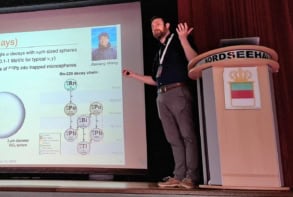New calculations by physicists in Europe could help reveal the origins of ultrahigh energy cosmic rays (UHECR). The work identifies a tiny but telltale feature in the UHECR energy spectrum that if verified experimentally should help astronomers determine how far UHECRs have travelled before they reached Earth (Phys Rev Lett 97 231101).
With energies of 1018-1020 electron volts (eV) UHECRs are the most energetic charged particles in the Universe. However, they are exceedingly rare and their origins remain a mystery – they could be produced at the far edges of the Universe or in nearby galaxies.
The most promising way of determining how far UHECRs have travelled to Earth involves understanding how they interact with the cosmic microwave background (CMB) radiation that they encounter along the way. At very high energies, UHECRs should lose energy by colliding with CMB photons to produce pions. If the cosmic rays have travelled great distances to reach Earth, successive collisions would lead to a rapid decline to zero in the number of UHECRs observed with energies above about 4×1019 eV – the so-called Greisen-Zatsepin-Kuzmin (GZK) cut off. On the other hand, if a UHECR is produced within a nearby galaxy, it could be observed at energies above the GZK cut off.
However, the precise nature of the GZK cut-off is highly dependant upon the theoretical assumptions made when calculating its position. This is further complicated by the existence of a nearby second cut off – the “acceleration limit”. This is the absolute upper limit on cosmic ray energies and could be confused with the GZK cut off.
But now Venya Berezinsky of Italy’s Gran Sasso Laboratory and colleagues in Belarus and Norway have postulated the existence of a unique structure in the UHECR spectrum, that if observed would provide conclusive evidence of a GZK cut off. The tiny dip is calculated to occur at about 6×1019 eV and its position is not highly-dependent upon theoretical assumptions. Berezinsky told Physics Web that it should allow physicists to separate unambiguously the effects of the acceleration limit from the GZK.
Unfortunately, the second dip is such a subtle effect that Berezinsky believes that it will probably not be seen in data from existing UHECR detectors including the Pierre Auger Observatory in Argentina. Instead, researchers may have to wait until the JEM-EUSO UHECR detector is up and running on the International Space Station, which should happen in 2008.



